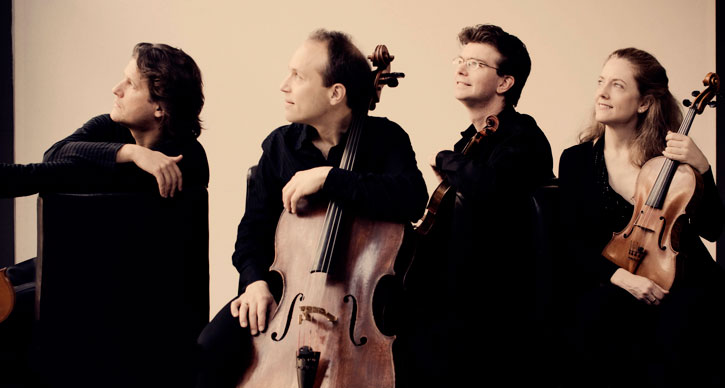The St. Lawrence String Quartet presents Haydn, Golijov, and Schafer
Author’s note: This article was written in November 2011 in anticipation of the St. Lawrence Quartet’s originally scheduled performance in Ann Arbor. Since then, composer Osvaldo Golijov has been entangled in a controversy over his extensive use of another composer’s music in his orchestra piece Sidereus. I wrote about the imbroglio on Sequenza21.com, but the most recent reporting on it is from the Philadelphia Inquirer.
Kohelet, the Golijov work programmed on Thursday’s concert, is also entangled in the borrowing scandal. Earlier this winter, a Brazilian journalist identified and confronted Golijov about his borrowing of a pop song in the string quartet. According to the Philadelphia Inquirer, Golijov has replaced that part of Kohelet since its November performance in Philadelphia, which, ostensibly, would have been the version of the piece performed in Ann Arbor last November.
With that said, please proceed to read my thoughts on Thursday’s program. What has happened to Golijov since November is exciting, but, truthfully, doesn’t have much to do with the St. Lawrence Quartet – simply, the situation adds a little more spice to what is sure to be a thrilling concert Thursday evening.
– GS
Photo: St. Lawrence String Quartet. Photo by Marco Borggreve.
The St. Lawrence Quartet’s trip to Ann Arbor has been highly anticipated since its announcement because of the group’s collaboration with renowned Argentinean composer Osvaldo Golijov. The recipient of some of the most prestigious awards offered to composers, Golijov’s music is among the most widely beloved in the world of contemporary music because of its unabashed reference to the composer’s unique upbringing. The child of exiled Romanian-Jewish parents, Golijov was raised in Argentina at a time when that country’s musical idea was taking shape, engendering his output with a broad base of cultural allusions spanning Eastern European Klezmer to the Tango music of Astor Piazzolla. Yet, in an intriguing twist of fate, the Golijov work we will hear on November 12 may not be the finished product of the St. Lawrence Quartet’s commission. As least as of October 24, Golijov’s piece had not been finished, described by the composer as “embryonic.”
The available criticisms of the composer’s alacrity notwithstanding, the unusual circumstances of the St. Lawrence Quartet’s upcoming performance provide you, the listeners, with an opportunity seldom offered to audiences of classical music: you get to hear a piece that is still alive. As a composer, I often stress to the performers I work with that the score is not etched in stone. In other words, every piece evolves as composers and ensembles collaborate, but the audience rarely gets to participate in that growth because the standard repertoire typically programmed on classical concerts is totally intransigent and has been for centuries. Although I cannot speculate more specifically as to how Golijov’s work – titled Kohelet – will sound, it is more than likely the St. Lawrence Quartet’s performance will be the only of its kind, ever. How often are concertgoers given a chance to hear something no other audience will experience?
Though the Golijov deadline controversy is the juiciest storyline related to the evening’s music, I imagine R. Murray Schafer’s String Quartet No. 3 will be the most memorable piece to most of the audience. Schafer is a well-known, successful Canadian composer who is experienced writing for string quartet and String Quartet No. 3 may be his best effort in the genre. The work is poignantly, aggressively expressive thanks to Schafer’s masterful use of the ensemble’s color. In fact, much of piece’s beginning exploits the homogenous sound of the quartet, delicately shading unison lines that moan with microtonal inflections and tightly bunched dissonances. Schafer is wise because he lets his material breath before developing it, which makes his abstract musical language easy to engage with if you’re an attentive listener. The second movement is extraordinarily divergent from the first with its high energy and pervasive vocalizations in the string parts. That’s right, we will all hear the members of the St. Lawrence String Quartet hum, growl and make other vocal sounds as they play. Most satisfactory is how Schafer uses these unusual effects to add to the string parts, compellingly decorating the frenetic quartet writing instead of throwing the vocalizing into the fray as some kind of gimmick. Keep the first in second movements in your mind as you listen to the third because the way Schafer coalesces the contrasts of the preceding sound worlds is extraordinary.
Of course, book-ending these modern compositions are two string quartets by Joseph Haydn, one of the most prolific composers of the Classical Era. Both works are extremely traditional and should pair nicely with Golijov’s Kohelet and Schafer’s String Quartet No. 3 insofar as the full breadth of the genre will certainly be on display. The first Haydn work is the String Quartet no. 57 in C Major, which has four delightful movements – in whole, an ideal aperitif to an evening of string quartet music. My favorite moment comes in the second movement, labeled “Andantino”, where Haydn, after briefly setting the stage introduces a stunningly delicate theme memorable to me both for its pithiness and characteristic octave doubling. Closing the concert is the String Quartet no. 61 in D minor, with its brooding opening movement that contrasts so starkly with the humorous pizzicato that accompanies the first theme of the second movement. The work’s finale opens rather nervously, regaining the angst of the opening movement and instilling it with more energy until, suddenly, the mode shifts and things brighten into the comfortable, pleasant closing bars of the piece.







